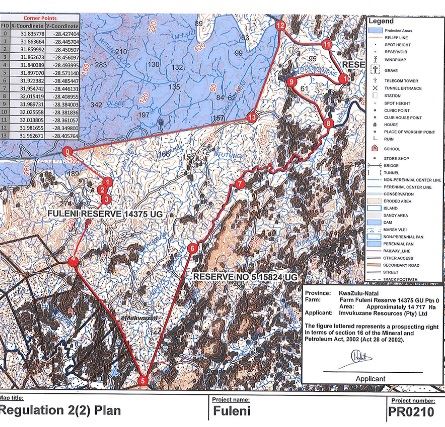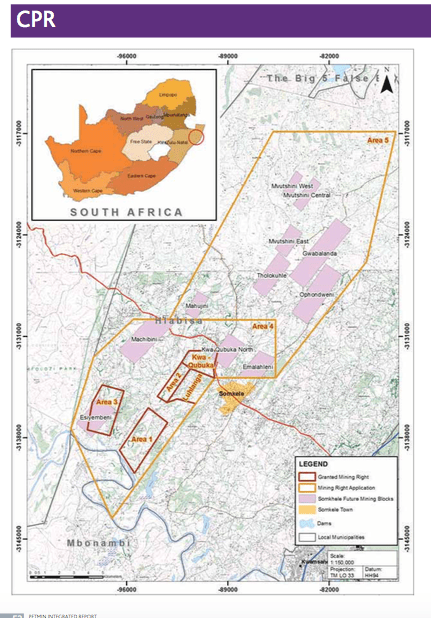Update with new information (July 12): "Tendele's mining right that was under appeal was granted in 2016 (not 2017) after an extended consultation process which included the park. This mining right is in the Mpukunyoni area and not Fuleni. It was appealed as people thought it was in the buffer zone, and that we didn't consult and didn't follow necessary environmental legislation – which the Minister then rejected, confirming that we acted 100% within the legislation and could prove consultation was done. Important to note: we have no relation to Fuleni or Imvukuzane; their reserve runs on the other side of the iMmfolozi River," says Tendele COO, Jarmi Steyn.
KwaZulu Natal’s oldest game reserve, the Hluhluwe-iMfolozi Park (HIP), along with its neighbour, the Fuleni Reserve, may come under threat by yet another coal mining prospector tendering for mining rights on its borders.
For the second time in four years, the reserves, their habitant wildlife and fragile ecosystem, as well as the surrounding communities, are potentially being threatened by mining companies tendering to establish open-cast coal mines in their midst. The historic wilderness zone, now covering nearly a third of the HIP, is home to some of the densest populations of White rhino in the world – an endangered species. This zone was given special protection because it was largely unscarred by development.
Tendele Coal Mining has been operating in the area for 11 years, with approved mining rights for current and future areas, says Chief Operating Officer, Jarmi Steyn. “Tendele abides by the required legislation and its regulations as prescribed, and has extensive monitoring and management programmes in place to minimise pollution and damage to the environment as prescribed. It is important to note that the HIP is an interested and affected party of the mine, and was consulted with all mining rights applications. It’s also worthy to note that all the mine’s active areas are outside of the 5km buffer zone of the park.
Important to note- we have no relation to Fuleni or Imvukuzane - their reserve runs on the other side of the umfolozi river.
Ibutho Coal applied for mining rights in Fuleni four years ago, but it is alleged that the project was abandoned following strong opposition from Ezemvelo KZN Wildlife and the local community. An environmental impact report on the Ibutho project suggested that hundreds of people would have to abandon their homes, businesses, farming plots and ancestral graveyards; while the direct impact of blasting vibration, dust, noise and lighting would be felt 24 hours a day, seven days a week for over 30 years.
Limpopo-based environmental consulting firm Jacana Environmentals, suggested that the noise from up to 200 coal trucks a day would radiate to distances of around 1.5km during the day and 3.5km at night. This noise would affect the tranquillity of the nearby HIP. Furthermore, it was estimated that Ibutho would require 105m litres of water a month – despite the iMfolozi River already being considered ‘water stressed’. Surface and groundwater in the vicinity of the mine would be poisoned from acidic mine drainage and other contaminants, while underground mining would cause the ground to subside.
On May 22 this year, Imvukuzane Resources applied to South Africa’s Department of Mineral Resources (DMR) for environmental approval to prospect for coal and other minerals, and to dig 275 test boreholes in the Fuleni area, directly adjacent to the southern boundary of the HIP. This has the potential to affect 16 500 inhabitants in the local communities, and have serious environmental impacts through “noise, blasting, coal dust, water extraction and pollution, light pollutions, contamination of soil, destruction of agricultural and grazing land, displacement of thousands of people,” says Save Our Wilderness.

The area under tender for mining rights by Imvukuzane Resources.
Tourism Update approached the Department of Mineral Resources to query the considerations put in place with regard to the above effects on the environment, wildlife ecosystem, their consequent tourism, and on the local communities. The Department’s spokesperson, Ayanda Shezi, said: “The law requires that when an application for mining or prospecting is being considered, a thorough assessment of environmental impact be undertaken to establish if the proposed activities will have an impact, and the severity of that impact.”
The process of engagements with all stakeholders is prescribed in terms of Chapter 5 of the National Environmental Management Act 107 of 1998, read with the Environmental Impact Assessment Regulations, 2014 EIA Regulations, and undertaken by an Environmental Assessment Practitioner who upon finalisation of that process – including the associated consultation with all Interested and affected parties, submits the EIA to the Minister for consideration.
In the event that a mining right is granted, there is a further process in terms of section 5 of the Mineral and Petroleum Resources Development Act (MPRDA) that requires the mining right holder to consult with the landowners and lawful occupiers. The mine owner must still comply with all the laws of the land and best practices regarding the management of relocations.
The impact in this instance (tourism to the reserves) gets to be analysed during the EIA process as determined in the EIA regulations.”
On August 31 2017, Tendele applied for mining rights to 222sqkm within the Fuleni Reserve, which was appealed by Save Our Wilderness. On June 19 this year the appeal was rejected by the Minister of Mineral Resources, Gwede Mantashe, on the following grounds:
- The application was rightfully adjudicated in terms of the now repealed section 39 of the MRPDA, read with regulations 49.50 and 51.
- The amendments in both MRPDA and NEMA do not apply retrospectively, and the acting DG rightfully considered the provisions in the unamended MPRDA.
- The regional manager has confirmed consultation with interested and affected parties.”

The 222sqkm area under tender for mining rights by Tendele Coal.
Steyn says that in general, Tendele “tries to communicate with such bodies in order to provide information and detail. In many instances it is found that environmental complaints and resistance relates back to employment opportunities and unsubstantiated compensation related issues. It must be noted that the area in which the mine operates has a very high unemployment rate and poverty is rife – any propaganda sees opportunity for alleviation of these challenges. Tendele has furthermore created a structure called the Mpukunyoni Community Mining Forum (MCMF), where all leaders and community representatives are present – municipality, traditional council, community committees and the like. NGOs are welcomed to the meetings of the MCMF, but to date, none have been willing to accept our invitations. Tendele furthermore has an interested and affected parties database whereby such parties are informed of the Mine’s doings/plans and comments and suggestions are noted and actioned.”
While the appeal against Tendele’s application was rejected, a number of conservation and local-community bodies have raised a powerful call for support to stop Imvukuzane Resources’ application. “The more people who register as Interested and Affected Parties (IAPs), the stronger and clearer the message to the Department of Mineral Resources that coal mines in rural farming communities that threaten HIP are not to be considered. Neighbouring communities derive far more jobs and sustainable benefits from the park and tourism than from coal mines that leave serious environmental, social and economic devastation behind and invariably do not rehabilitate the area despite legal obligations to do so,” says Save our Wilderness.
Imvukuzane Resources, however, remains a ghost to media enquiries. An investigation conducted by the Daily Maverick suggested that Imvukuzane was only set up in April, and currently has a single director (a 33-year-old Pretoria attorney), and no attempt to obtain comment from the company, its employees, or any linked parties was achieved. Tourism Update’s own investigations and attempts to make contact with the mine were unsuccessful.
Imvukuzane’s application is still under consideration, says Shezi, “and no final decision has been taken”. “The Department takes very seriously the impact any proposed mining activity has on the environment. Its processes are bound by the principles of Integrated Environmental Management and Chapter 5 of NEMA, and as such, all decisions made take into due consideration all the environmental and socio-economic factors,” she concludes.






















